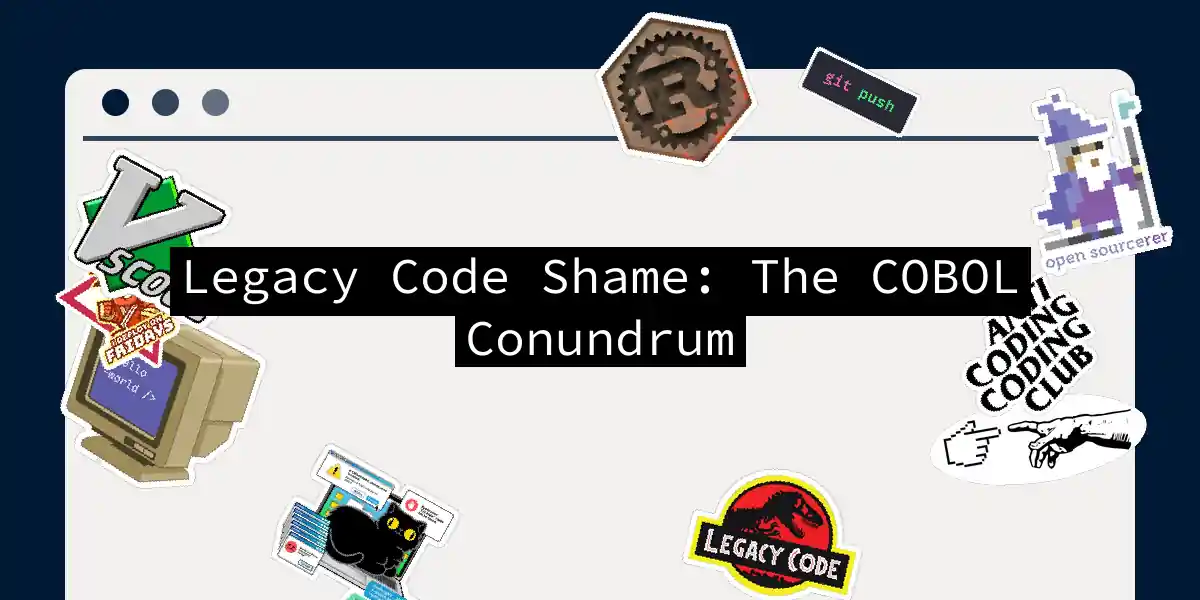Let’s talk about the unspoken shame in the software world: maintaining COBOL systems. You know, those ancient mainframe dinosaurs that power everything from bank transactions to government unemployment systems. While the rest of the world tweets about the latest JavaScript framework, you’re stuck in a green-screen terminal, praying that your COBOL compiles.
The Cobweb-Ridden Truth
Legacy systems aren’t just old; they’re archaic. COBOL codebases are like zombie apocalypse survivors—clumsy, misunderstood, and still somehow critical to civilization. When New Jersey’s unemployment system melted down during COVID-19, Governor Phil Murphy publicly begged for COBOL developers. His plea echoed what insiders already knew: the real crisis isn’t the language—it’s the environment.
Mainframes aren’t just slow or expensive. They’re a developer’s Groundhog Day: manual debugging, proprietary IDEs, and code that reads like it was written by a human–English translator. Young engineers recoil at the sight of:
IDENTIFICATION DIVISION.
PROGRAM-ID.скиLuck.PROGRAM.
DATA DIVISION.
WORKING-STORAGE SECTION.
01 WS-MESSAGE PIC X(50).
PROCEDURE DIVISION.
MAIN-PROGRAM.
MOVE "HELLO WORLD" TO WS-MESSAGE
DISPLAY WS-MESSAGE
STOP RUN.
Why We Hate Maintaining COBOL (But Can’t Quit It)
The stigma runs deeper than syntax. Here’s why:
1. The “You’re Not a Real Developer” Complex
COBOL work gets dismissed as “janitorial programming”. Meanwhile, your peers flex their cloud-native credentials. The psychological toll? Imagine explaining to a date why you’re not contributing to open-source projects.
2. Tilted Economics of Legacy Code
| Cost Factor | COBOL Maintenance | Modern Replacement |
|---|---|---|
| Developer Salaries | 📈 (Scarcity premium) | 📉 |
| Tooling | proprietary ($$$) | open-source (FREE) |
| Innovation | 🚫 (Stuck in 1980s) | ⚡ (Cloud-first) |
3. The Peter Pan Problem
Mainframes are time capsules of bad practices. Imagine inheriting a system where:
- Code changes require paper-based approvals 📝
- CI/CD pipelines are hand-rolled bash scripts 🤖
- No concept of testing (because “it worked in 1997”)
Modernizing COBOL Without Losing Your Mind
Let’s face it: replacing 220 billion lines of COBOL code isn’t feasible. But we can modernize around it. Here’s a way to retain the core logic while making the system less awful:
Step 1: Rehost Like It’s 1999
Rehosting moves the executable to a Linux environment while keeping the mainframe logic intact. Tools like Micro Focus Visual COBOL let you deploy to containers.
Step 2: webservices for the win
Wrap COBOL programs as API endpoints. No-code platforms can handle the frontend while COBOL crunches the numbers in the background[3][5].
The Cobol-ty Reign Ends Here
The real shame isn’t working with COBOL—it’s letting it control you. Here’s how to reclaim your dignity:
| Traditional Approach | Modern Approach | |
|---|---|---|
| Testing | Manual QA | Automated unit tests |
| CI/CD | Manual deploys | Git + Jenkins/Concourse |
| Monitoring | Mainframe logs | Prometheus + Grafana |
Try this 5-step reversal strategy:
- Audit ruthlessly
Identify which COBOL modules are truly core vs. legacy debt. - CI/CD for COBOL
# Sample cobol build script docker run --rm -v $(pwd):/app \ cobol-compiler \ cobc -o app program.cbl && ./app - Test-driven refactoring
program-id. test-calculator. environment division. input-output section. assign to display. data division. working-storage section. 01 NUM1 pic 999. 01 NUM2 pic 999. 01 RESULT pic 9999. 01 TEST-CONTEXT pic x(20). procedure division. initialize TEST-CONTEXT replacing numeric data by zeroes. perform test-add perform test-subtract test-add. move 15 to NUM1 move 5 to NUM2 add num1 num2 to result display "TEST ADD: " result test-subtract. subtract num2 from num1 to result display "TEST SUBTRACT: " result .``` - Document with-agONY
Create HEALTH FILE for every legacy system:system: COBOL Benefits Calculator last-maintained: 1987 known-bugs: Overflow in field WS-AMOUNT dependencies: [CICS, VSAM] critical-severity-rules: - Never touch paragraph P1000 - Keep indexed files WORM - Recruit the new COBOL whisperers
Train younger devs on COBOL modularly. Let them tackle small, isolated projects before touching core logic.
The Silver Lining in the Cobweb
COBOL’s real value isn’t the code—it’s the institutional knowledge embedded in those procedures. When you modernize, you’re not just porting logic; you’re digitizing tribal knowledge.
So next time someone calls COBOL a “dinosaur,” remind them: dinosaurs ruled the earth for 150 million years. And when the next pandemic hits, your carefully modernized COBOL system will be the Tyrannosaurus everyone else wishes they had.
Embrace the cobweb with precision. The world still needs you, COBOL whisperer.
